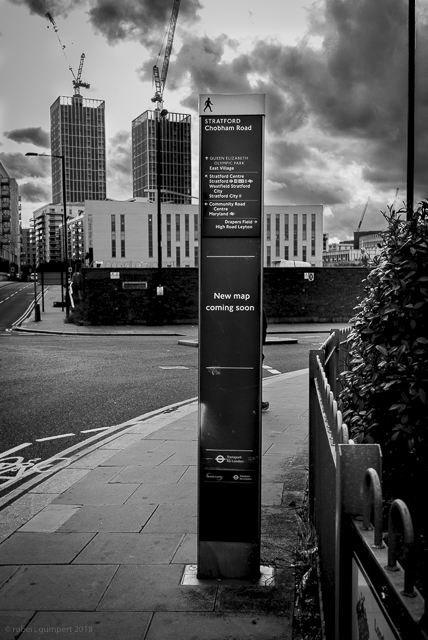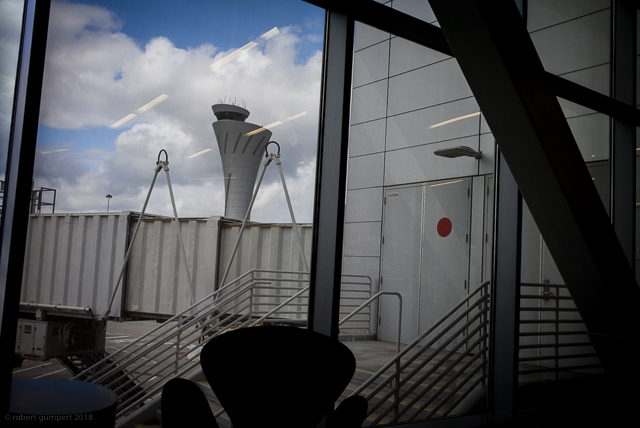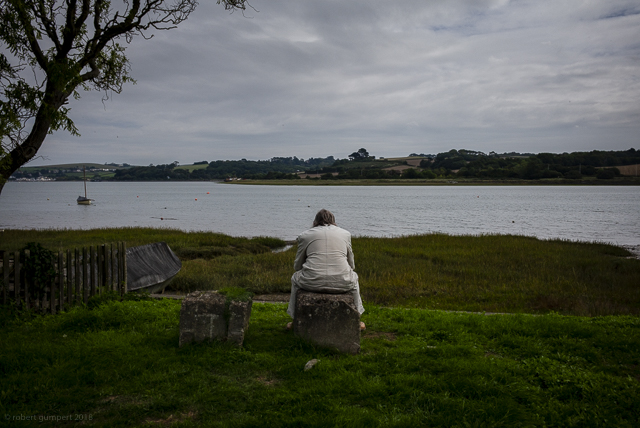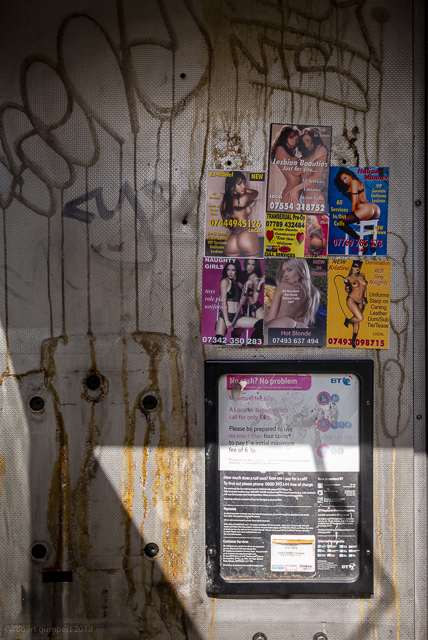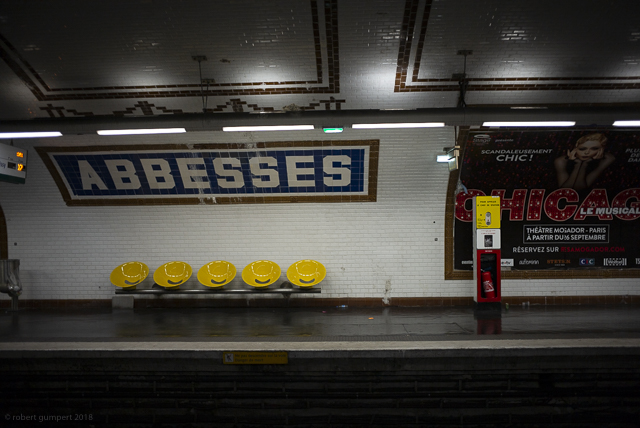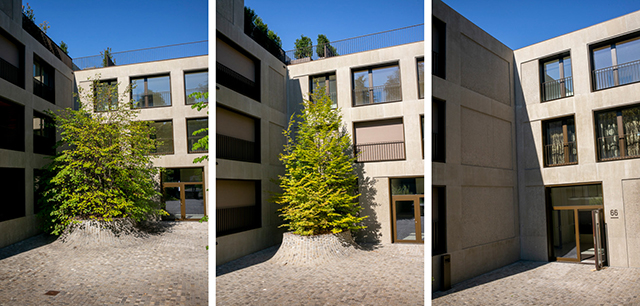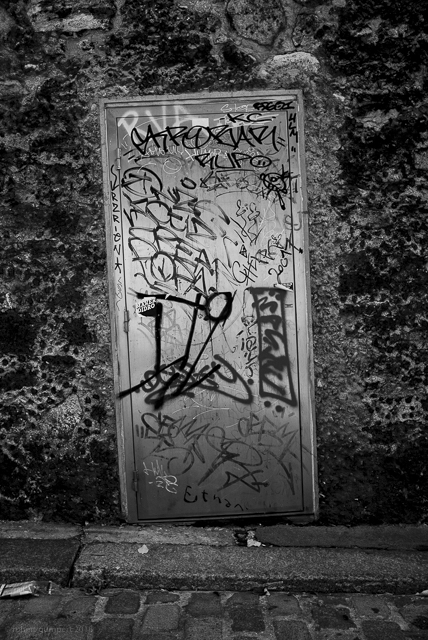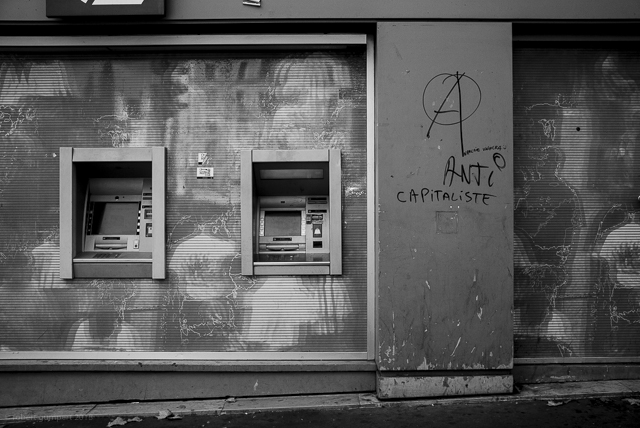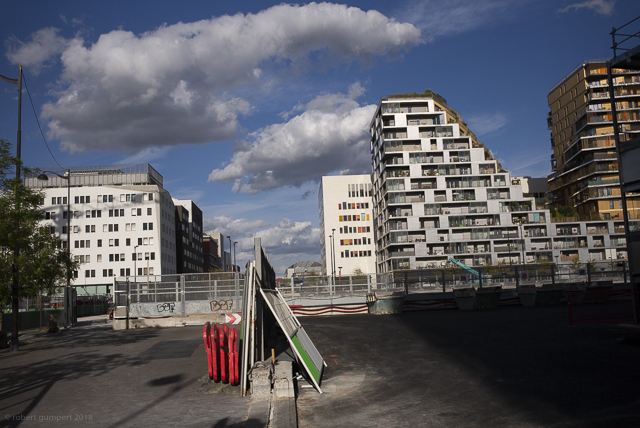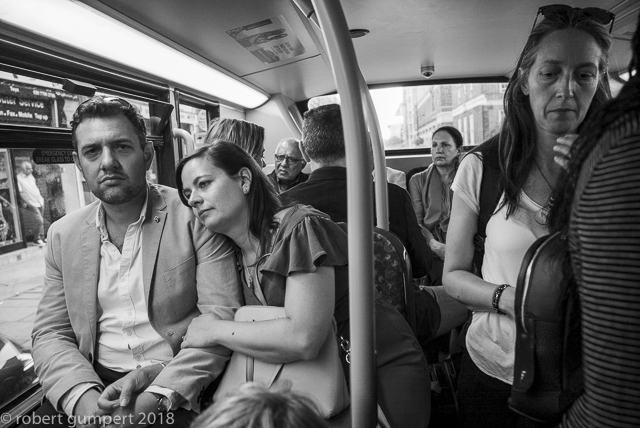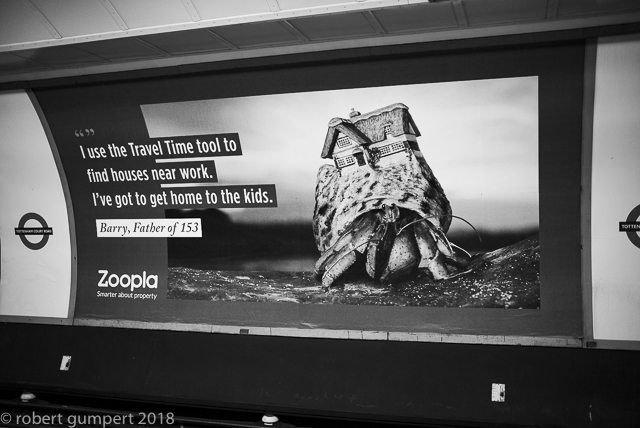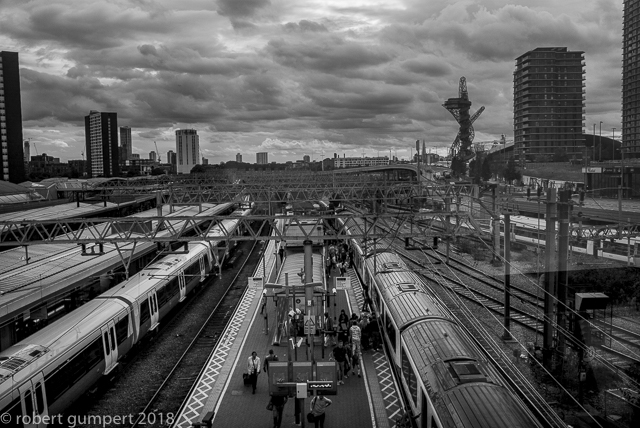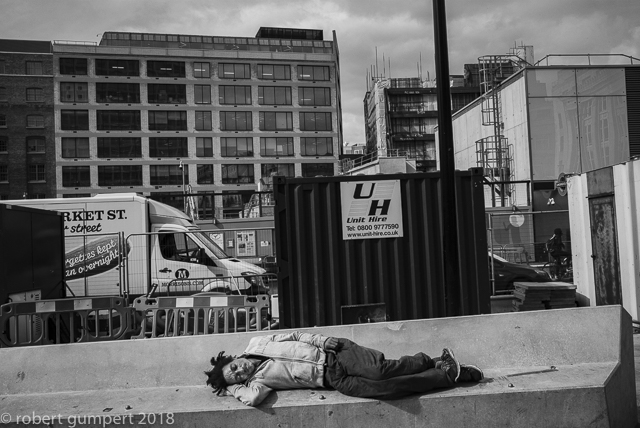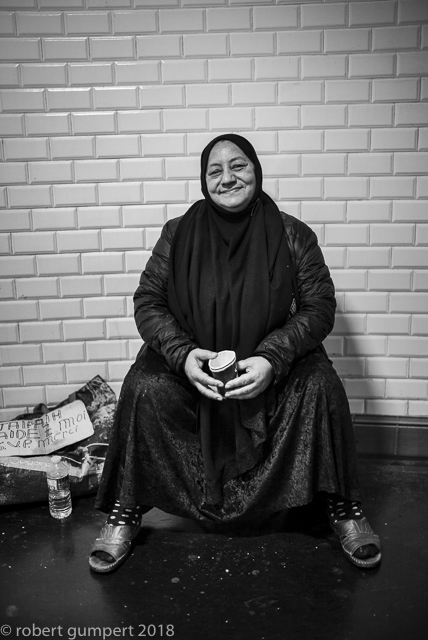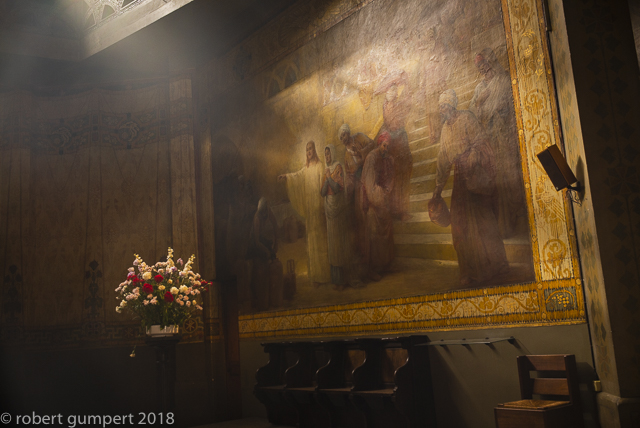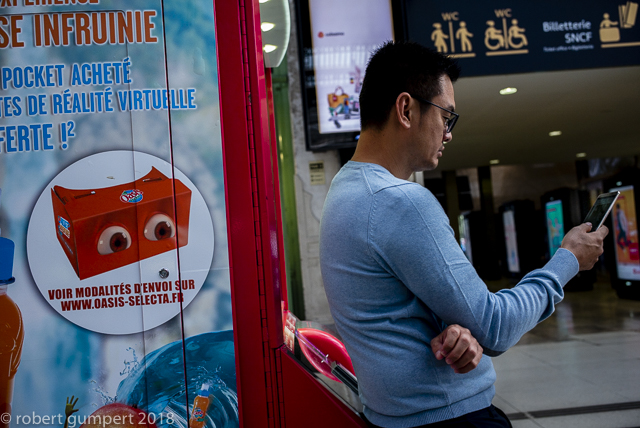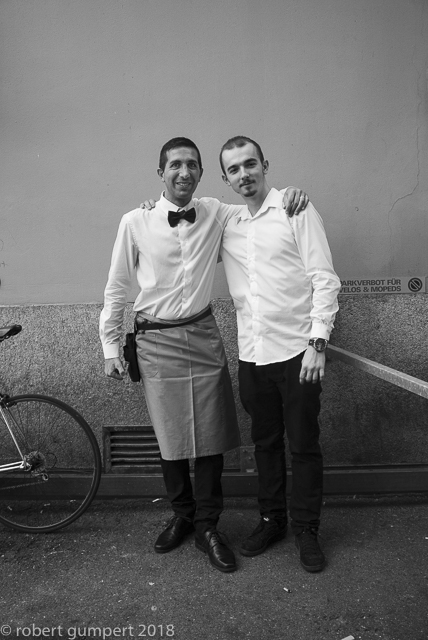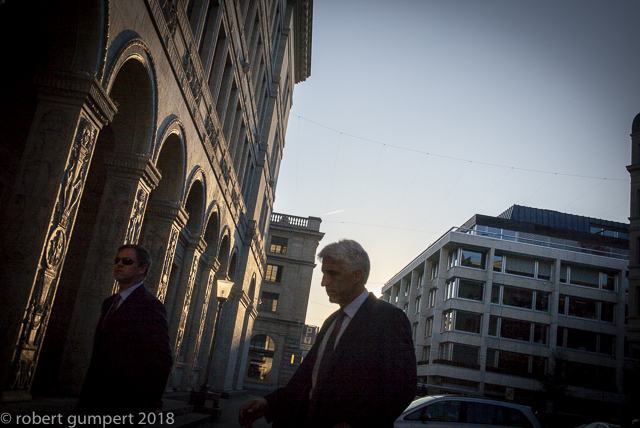Is it possible to have Expedition Cruises?
By Robert Gumpert
It’s Sunday morning, the 11th of November, and in San Francisco the sky is as it has been for the last few days: gray and smelling of smoke. Late news last night was 23 have died in the Camp Fire north of Sacramento, where San Francisco’s smoke-filled air originates.
In the south, Martin Sheen and his wife apparently slept on the beach as parts of the Malibu colony of stars either burned or threatened to burn. Reports are two have died here.
Once again California is going up in flames. The President, who canceled a short walk through a WW1 graveyard of fallen soldiers because of a drizzling rain, tweeted that the fires in California are a product of gross mismanagement and his government won’t be sending any help until management of the resources changes. In the meantime he and Rick Scott are claiming fraud in an election not yet decided, in an election time where the real fraud is voter suppression committed by the party in power. When you come right down to it, the Republican’s are sort of Maoist in that they keep saying there needs to be a revolution against the government they are totally in charge of.
However none of this is what brought me to the computer this morning in my somewhat oxygen-starved brain. It is “T” magazine-Sunday at the New York Times, and time to see what “things” await me if somehow I can figure out how to make a lot of money. Mind you “T” is paired this week with the “New York Times Magazine” whose cover story is “How Law Enforcement Failed to See the Threat of White Nationalism”. Right there on the kitchen table is America: Racism, Money, and Power.
“T” magazine’s readership is extremely well-heeled, hence the number and type of ads. An early one caught my eye, “Where Luxury Roams Freely”. It’s for “Crystal Yacht Expedition Cruises” with a photo of the gleaming white “all-suite, all-butler, all-inclusive luxury expedition ship” motoring through some remote Arctic, or perhaps Antarctic sea.
So here I am in SF. My state is covered in flames and smoke; firefighters and prisoners are battling the flames to try and save what they can during a drought brought on by mismanagement. The mismanagement of corporations and their representatives in government, and I’m wondering just what the hell is a luxury expedition?
…
Of Two Minds
By Sarah Shourd
The term “bridging divides” bothers me. Can meaningful dialogue exist between people that are deeply divided? It often feels pretty unrealistic, especially when real conditions in the world are the basis for that division. For example, why would an African-American be interested in “bridging” with a White Supremacist? How can we expect words alone to shift such deeply entrenched and systematic oppression? What’s the point of that?
We can’t, of course. But there’s also very good reason to try and learn from people in geographic, social and identity groups different from our own. Global warming, for example, gun violence, or the future of artificial intelligence, those are good reasons. None of these problems can be addressed with out a lot more people in this country and this world getting on the same page about them.
As a host interested in exploring the nature of difference, this was an obstacle for me
I recently put out a podcast, Of Two Minds, that puts two people in conversation that are deeply divided. The object is to understand the nature of their difference. Is it ideological? Cultural? Do people with opposing views want irreconcilably different worlds or do they just have different ideas about how to get there? I’d love to share a little about what I learned along the way.
It’s not easy to work against the way we’re been wired: socially, experimentally and even neurologically. A lot of our beliefs were formed out of loyalty, to win approval from our friends and family. Or even survival. We individuate as we get farther from our origins, but most of us never veer too far. Yes, we are also rational beings, but we tend to reinforce the beliefs we were given through the books we read and culture we partake in. Often our experiences in life more deeply entrench the emotional core of our belief systems.
In an attempt to challenge this on Of Two Minds, I asked my guests to listen to each other’s back-stories before putting them in conversation. They listened to stories about how the other guest felt as a child, what their parents were like, the first time they fell in love, and times in their lives they felt desperate or scared.
After hearing these intimate details, I often found my guests disarmed. Then, when I put them in conversation, I found they wanted to minimize their differences and focus on what they had in common. These were people who disagrees about whether global warming was real, whether police violence was motivated by racism and now they wanted to talk about what it was like to run in the forest as a child, be parents or cook gumbo. In most cases, they began to like each other.
As a host interested in exploring the nature of difference, this was an obstacle for me. Two people I’d brought together on the basis of their difference were now reluctant to disagree. They didn’t want to come across as rude and judgmental. They just wanted to have a nice chat.
Getting to know a person’s inner life is a little like falling in love, right? All we see at first is what we like, what we have in common, what we can empathize with. And sometimes that euphoria of connection temporarily blinds us.
These, days the legacy of that history feels all too real.
This was exasperated by the fact that most of my guests also came into the conversation with a lot of anxiety and distrust – so much, in fact, that they were sometimes reluctant to go through with the conversation at all. The anxiety, I believe, stems from the deep distrust: a distrust of politics, a distrust of one another and a distrust of journalism.
The distrust of journalists as a group is deeply troubling. On one hand I understand it, a lot of unethical and bad journalism has come out of the Internet age. On the other hand, a lot of powerful people, like our President, want the public to distrust journalists because they don’t want the horrible and unethical things they do to come back to them. They don’t want you to know the stories that aren’t being told because it’s often them that are to blame.
Powerful people in American history have successfully kept America divided along social, political, class, racial and geographic lines since its inception. In the 17th century poor whites and freed slaves were systematically pitted against each other to prevent them from joining forces against plantation owners. These, days the legacy of that history feels all too real.
We live in a huge, astoundingly diverse country. In order to have empathy for our fellow citizens, we have to spend a lot of time trying to understand what their lives are like, why they believe what they do and what makes sense in their context. Someone in San Francisco may never have the chance to meet someone from rural Louisiana or Kansas or DC in person. Yet, we think we can convince them we know what’s best for them in regards to healthcare or global warming, without understanding the context for their beliefs.
What doing these interviews really brought home for me — again and again — is that I was reminded that people navigate the world in their own context, not mine. And every context is different, sometimes in pretty significant ways.
One great thing I found was that when our guests got past their anxiety and dove in, they often came out of the conversation feeling better. Most of them enjoyed the opportunity for an honest conversation with someone with a different point of view.
There are differences that matter and differences that don’t matter. The fact that we both like strawberries, or feel compelled to sit on a bench every time we pass by one, might not be basis enough for us to fall in love, or fight for a clean planet together, but it might open the door just enough to see if that’s even possible.
…
Two old salts say get a job at Amazon!
By Rand Wilson and Peter Olney
Amazon plays a key role in the twenty-first-century economy and has shown it’s vulnerable to pressure. Socialists should get jobs there and organize.
Raised up by resistance to the war in Vietnam and the battle for civil rights in the 1960s and seventies, we were part of a generation of young Americans who realized that the industrial working class was the force capable of making major political change in the U.S. This was certainly a stretch for many of us who had grown up in the comfortable suburban middle class with little contact or experience with workers. However, our involvement in social movements exposed us to Marxist concepts of class analysis and the role of class conflict in historical change. The organization of workers is central to that theory and to our own history of social and economic progress.
For thousands of like-minded radicals like us, it was farewell to professional careers and off to the factory.
At that time in greater Boston, it was relatively easy to get a job at one of the three Generals, the giant Fore River Shipyard in Quincy owned by General Dynamics; General Motors in Framingham; and General Electric in Lynn. (Today only General Electric remains — a small shell of its former self.) All three of the Generals employed dozens of idealistic lefties committed to a broad vision of radical change.
There we learned the hard lessons of the challenges of building on-the-job unity and working-class organizing, plus lifelong lessons in humility and respect for the mind-numbing tedium of work and the joys and rewards of successful organizing. Forty years later that was “once upon a time” when revolution was “in the air.”
Fortunately, Bernie Sanders’s candidacy and the resistance to Trump has inspired a new generation of organizers and activists. While much of the resistance has taken the form of street demonstrations and electoral political action, many of these new organizers are grappling with the same thorny questions of how to build working-class power to change the economy and the country.
Naturally, some of that activism focuses on the same macro forces that drive our economy. Young organizers are again looking at big industries and giant companies where a collective effort might affect significant change. While manufacturing and the strategic industries of the past are still important, we see the logistics supply chain as a place where an organized and invigorated working class could exercise power. And the inspiring teachers strikes in West Virginia and elsewhere are harbingers of the kind of mass activity necessary to rock the system in the post-Janus, Trump years.
We urge young organizers inspired by Sanders, the pushback to Trump, and the teachers’ strike wave to look at targeting an employer that plays a strategic role in the economy, symbolizes the melding of technology and high-powered logistics, and has shown it is vulnerable to organized pressure. That company is Amazon.
Amazon in the retail vanguard
Amazon’s recent purchase of Whole Foods and its decision to site a second headquarters in another major city have further raised its profile in the business and popular media.[1]
While Barnes and Noble is closing its bookstores, Amazon is actually opening bricks and mortar bookstores. The company currently has 14 Amazon Books stores open nationwide with three more on the way.[2]
Amazon is now piloting clerkless stores that could become a model for the future of retail.[3] Customers will only need to swipe their credit cards at merchandise and walk out with their goods without interacting with a single human being. Amazon has already used delivery drivers with drones for making deliveries in select markets.[4] Amazon has announced a patent for an employees’ bracelet enabling it to monitor employees’ work at all times.[5]
Amazon’s advanced use of robots in warehouses is already displacing living, breathing human workers.[6] And its management of professional and technical staff (“If you’re a good Amazonian, you become an Amabot.”) is setting new precedents for white-collar oppression.[7],[8]
Does Amazon’s disruption of existing distribution systems and retail sales models add up to a company where workers can even dream of organizing to improve their wages and working conditions? One good sign is the company’s recent announcement that it would raise wages for employees to $15 an hour. The pay raise came about as a result of public pressure — led by Bernie Sanders — and a tight labor market going into its peak season. But at the same time it raised wages, Amazon cut other benefits and stock options.
Unilateral actions like this are a shop floor organizer’s dream. Suddenly, there is widespread and open discussion about wages and working conditions. In the hands of a politically conscious organizer, those conversations inevitably lead to a conversation about our collective power and unions.
Could a movement in this environment emerge to demand — and win — collective bargaining? Emphatically yes. And the stirrings at Amazon are worldwide: workers in Italy, Germany, Poland and Spain are uniting for better conditions, while organizers in the U.S. are looking at the giant online distribution network as a strategic imperative for labor’s future.[9] We believe that Amazon’s high public profile and just-in-time delivery model are factors that — if combined with a well thought out strategy — could empower workers to succeed.[10]
The challenge
Amazon is the third-largest retailer in the world (after Wal-Mart and CVS) and is now the largest online retailer edging out Alibaba, the Chinese online distributor.[11] Until very recently Amazon relied solely on online sales, but with its acquisition of Whole Foods, its business model is changing.[12] Amazon operates worldwide with distribution/fulfillment centers in over 18 countries. There are 351,000 employees worldwide and 280,000 in the U.S. alone.[13]
Distribution centers operate in the 25 major metropolitan areas of the United States.[14] Jeff Bezos, the founder of Amazon, is now the owner of the Washington Post with vast financial resources and an increasing role in national politics.[15]
Union strategists and organizers have been both inspired and chastened by recent organizing drives at Wal-Mart and ongoing Fight for $15 campaign. While an organizing campaign at Amazon is a daunting prospect, the labor movement was built at key moments by thinking big and acting boldly.
For example, thousands of garment workers were organized in New York City in the “Rising of the Ten Thousand” in 1909.[16] William Z. Foster’s strategic vision inspired organizers to plan and execute a brilliant strike at Big Steel in 1919.[17] While unsuccessful, the lessons and experience from this effort inspired future organizers who would eventually crack the industry 15 years later.[18] And of course, the iconic sit-down strikes in the 30s were conducted by organizers who understood the vulnerabilities in the production chain of giant auto companies like General Motors.[19]
Only twenty-one years ago, the International Brotherhood of Teamsters struck the premiere symbol of on-time deliveries: United Parcel Service. Once UPS’s inter-city “feeder” drivers stopped hauling between the company’s hubs and its package cars stopped deliveries, the strike’s impact was immediate.
Mere hours after the strike began, packages piled up and clogged the sorting belts at its distribution centers paralyzing the workflow. The Teamsters success in framing the walkout as a battle against part time and precarious work was a shining example of workers rising up to challenge one of the largest corporations in America.[20]
Get a Job! Get Rooted!
Looking back on our years of organizing experience,[21] we’d like to encourage young organizers to examine the potential for organizing and rebellion at Amazon.
All major organizing initiatives in modern U.S. labor history have benefited from politically conscious cadres who went to work in industries targeted for organizing. This practice has many names: industrializing, colonizing, rooting or the term we prefer, “salting.” It can be done for a lifetime or for short-term intelligence gathering and committee building.[22]
Success in organizing workers at a corporate giant like Amazon will only come if organizers, strategically placed and coordinated, can agitate and motivate their coworkers from a position of comradeship in the workplace.[23]
The opportunity and the place
Building a workers’ movement within Amazon would reshape the national narrative about labor and unions. However, there won’t be any quick or easy victories. Success will be intermittent and slow. All the aforementioned examples — successes like UPS and instructive failures like the 1919 steel strike — required long term approaches, dedicated cadres of organizers and strategic research.
Workers should approach organizing at Amazon with no less than a five- or ten-year plan. It is incumbent on the new generation of inspired organizers to get in on the ground floor, get jobs at Amazon and be part of fashioning the strategy and tactics that can lead to the creation of a new worker organization.
Amazon facilities are everywhere and there are already salts working together in key metro areas. Being part of an organizing network and connecting your work to a larger international effort is an exciting project. While Amazon is in or near every major city, some key strategic locations include Chicago, Dallas/Houston, Los Angeles, the NY/NJ area and Seattle.
If you are ready to commit to this kind of organizing, then email either of the authors (Peter Olney at olneyrom@gmail.com or Rand Wilson at rand.wilson@gmail.com) and we will help you to establish contacts and think through your placement at an Amazon facility.
While the authors have worked as union staffers for many years, it was our early experience as organizing salts and rank-and-file union members that inspired and informed our work as organizers for the duration of our careers. The rank-and-file experience teaches patience, humility, and respect.
Without knowing firsthand the drudgery of work, the humiliation of having to obey a supervisor’s commands, and the reality of the strengths and weaknesses of shop floor organization, any organizer will be at a serious disadvantage. Should someone undertake salting at Amazon, you will not only be part of shaping a strategy and winning the union; the experience will teach you valuable lessons on what it means to be a working class organizer. Just as importantly, it informs a lifetime of good strategic thinking and sensitivity to workers’ struggles, from the warehouse on up. So, get in touch, and let’s do it.
.
Notes:
[1] “Amazon Chooses 20 Finalists for Second Headquarters”
[2] Amazon store listed by state
[3] “Amazon officially opens autonomous ‘Go’ grocery store in Seattle”
[4] “In Major Step for Drone Delivery, Amazon Flies Package to Customer in England”
[5] “If Workers Slack Off, the Wristband Will Know. (And Amazon Has a Patent for It.)”
[6] https://www.nytimes.com/2017/09/10/technology/amazon-robots-workers.html
[8] For more on Amazon’s abusive labor practices, read “Amazon Is a 21st-Century Digital Chain Gang”
[9] See “There’s Never Been A Better Time To Unionize Amazon” and “A Union at Amazon?” by Marvin Harvey in Notes from Below
[10] “Dear Amazon Workers: Unionize!”
[11] “The World’s Largest Retailers 2017: Amazon & Alibaba Are Closing In On Wal-Mart”
[12] “Remember when Amazon only sold books?”
[13] “Amazon to add 100,000 full-time U.S. jobs in next 18 months, growing domestic workforce 55 percent”
[14] “Amazon’s Newest Ambition: Competing Directly With UPS and FedEx” (Paywall)
[15] “The politics of Jeff Bezos”
[16] “Uprising of 20,000 (1909)”
[17] “The great steel strike and its lessons”
[20] “United Parcel Service strike of 1997,” https://en.wikipedia.org/wiki/United_Parcel_Service_strike_of_1997
[21] For more information about the authors, read about Rand Wilson here; Peter Olney here.
[22] Salting is the most descriptive term with two equally valid explanations. One is that the “Salt” is aggravating and exacerbating the open wounds and sores of capitalism. The other explanation is that a “Salt” brings out the rich ores in an industrial mine.
[23] For two good articles on salting, see Carey Dall and Jonathan Cohen. “Salting the Earth: Organizing for the Long Haul.” New Labor Forum, no. 10, 2002, pp. 36–41. JSTOR, and Steve Early, “Organizing for the Long Haul: Salting to the Rescue?”. And a book on salting, Michael Bussel, From Harvard to the Ranks of Labor: Powers Hapgood and the American Working Class
.
This piece originally ran in Jacobin on 4 October 2018 under the title “Socialists Can Seize the Moment at Amazon”
A few thoughts on class privilege and male dominance
By Helen Vozenilek and Molly Martin
The Supreme Court Senate hearings brought a few comments – here are two
No woman, of any color or creed, would come into a position of power such as a Supreme Court justice with the sense of entitlement that BK did. His and others’ supportive discourse focused on BK’s trajectory to this vaulted position. The weight lifting, the academics, the basketball practices that BK tearfully detailed, the drunken post-practice evenings when no one has a shit-ass McDonalds job to go to, reeked of private-schooled boys who compete in a sports arena completely inferior to those of public-schooled boys.
The 10 Democratic members of the judiciary committee, 3 women and 2 non-whites clearly have a lot more insight to privilege and entitlement than do 11 white men on the Republican side. But it is interesting that the most despicable three on this Committee – Orin Hatch, Lindsey Graham and Chuck Grassley, did not come from money or privilege or fortune. Bootstrap kind of guys. But nevertheless knowing their allegiance lies with other white men. Helen Vozenilek
.
I’m having a hard time writing about the Kavanaugh mess and I bet the others are too. We have been telling our sexual assault stories to each other and the world and we are wrung out, distraught, horrified. For me, an old feminist who’s spent my life working—often very successfully—for women’s liberation and equality, it’s a bloodying blow. I was one of many who helped women get abortions when they were illegal and then who worked to make abortion legal in Washington state before Roe v. Wade. Yes, we called for abortion on demand! But, while I was involved in the fights for reproductive rights, childcare (we lost that one), equal treatment in education and sports, my main focus has been helping women break into the male-dominated construction trades. Tradeswomen have always been on the front lines fighting sexual harassment and sex discrimination and with some success. Kavanaugh represents a class that wants to roll back all the hard-won gains of the feminist movement. I can hardly believe this but I think these guys want to see us barefoot, pregnant and back in the kitchen.
Sorry to say I can’t be more eloquent.
In sister and brotherhood, Molly Martin
Post cards from the Road, Part 2
By Robert Gumpert
Last week I showed photos and tried to make a case for directionless travel but never touched on the two big issues in the UK: Brexit and why, given the circumstances, is Labour not in power?
These questions were not ignored; I just am having a hard time understanding where my questions lead. I suppose that mirrors, in a way, the dilemma the UK faces over Brexit. So instead I will just note a few thoughts below.
Brexit
In France: Effectively I speak no French. I asked anyone with a remote semblance of English what he or she thought of the UK leaving the EU. Basically the response seems to me to have been, so what? It’s their choice and their problem to deal with.
In listening to and reading statements by the Tories it is clear the pro-Brexit group (hard or soft with it’s vaguely sexual connotations) simply don’t understand this, so they keep rabbitting on in their internal and public debate that the EU needs to come up with counter proposals, as if this leaving-thing was some sort of negotiation. The EU, or at least the French I spoke to, seem to be saying – you wanted to leave and while we are open to listening to your ideas for the EU’s relationship with the UK, leave. This is not to say that if the UK held another vote and voted to remain the EU would not welcome the development. The Brexiters who want the UK to be able/responsible for making its own actions don’t see the irony in their demand for EU participation.
A short talk with the North Devon Jag-driving taxi driver made it all quite clear when he said UK didn’t need to do anything, as the EU needed the money and would cave in. Not bloody likely, I think.
Up in London, about as much like the UK as SF, NYC and LA are like much of the US, the general mood seems to be there should be another vote, we don’t know what’s going to happen but the government (Tories) seem hell bent on jumping off a cliff but can’t figure out which one offers a better view on the way down.
In the past the big issue was the Irish border and what effect reestablishing an actual border might have on the peace agreements. This time around there is a bit of talk about uniting the two, although I have no idea of how serious that talk is. As well I have seen mention of having the UK/EU border run through the North Channel effectively leaving Northern Ireland as part of the EU. A position not supported by the rightwing Irish DUP giving the Tories their hold on power, thus rending the idea dead in the water, so to speak.
This last week May’s Chequers proposal, supposedly the UK’s last final, best offer to the EU was rudely discounted by the EU, France’s Macron, and Tory “hard” Brexiters.
However, during the ten days I was in England, the “remain” folks have picked up and expanded on the government’s own acknowledgment of the “supply chain” issues leaving represents. The Guardian ran a piece about English oysters being eaten in French restaurants because currently they are harvested, packed, shipped and on the diner’s Paris table in less than a half day. Without open trade borders the same oysters could take two weeks what with delays at the border for paperwork, inspections, and testing. Effectively killing the market. The same issues arise for multiple products, including manufacturing parts and medicines.
A story related to me was about one law firm enjoying a bumper time consulting with banks who want to move base to Ireland – still in the EU, English-speaking, offering open borders, open movement for workers and a lower cost of living than London.
Everyone I spoke with is uncertain. All would like to see a second vote on Brexit but only one person I know thinks it will happen, perhaps as part of a three way vote on whatever deal comes out after meetings in November offering the choices of Yes, No, and Stay.
But positions are in a fluid place and so it is not surprising that today, as I write this, the Guardian is reporting from the Labour Conference that Labour is prepared to vote down May’s final deal because of concerns over worker’s rights and environmental issues. They are willing to listen to calls for a second referendum.
The Labour Party and why the Tories are still in power
Why the Tories are still in power is perhaps for the same reason Theresa May remains in power. With the deadline only six months away, no one wants to be holding the bag when it all finally goes south. As a reason, it has some logic for me, but it is impossible to ignore the open warfare within the Labour Party.
Again this is really beyond my understanding given all that is going on and the stakes involved but I did talk to a number of friends, about 20 or so. One supports Brexit and is, I think, a likely Tory. Of the others, all but four are as perplexed as I am. Where exactly does Corbyn stand? Not sure? Are the constant charges of anti-Semitism leveled at the Left of the party true or a Trojan horse by the more centrist forces to rest power back from Corbyn and the Left? Don’t know, certainly possible.
Of the four, the breakdown is thus:
A friend from the Left is a supporter of Corbyn, one hundred percent. He points out that since Corbyn became head of the Labour Party, 500,000 new members have joined. He thinks Corbyn has good leadership skills and is handling both the challenge issues and the anti-Semitism issues effectively.
From a person I don’t know but met during the memorial for our mutual friend: He too pointed to the massive group of new members in the Labour Party, the Left taking over the reins of the Labour Party’s ruling committee as proof that Corbyn was in fact doing a good and effective job. For him there was no doubt that the charges of anti-Semitism were a Trojan horse. I don’t know this person’s politics or party but everyone at the memorial actively works on campaigns such as “Save Our Hospitals”.
An old friend, I think it is safe to say, hates Corbyn. When Corbyn was first elected head of Labour, my friend said it was an act of suicide by Labour and would led to total defeat in the coming elections. It didn’t. His position currently is Corbyn is actually a supporter of leaving (he appears to be, at best, a fence sitter) and is truly anti-Semitic.
The last is not opposed to positions laid out by Corbyn or the Left, but believes that there is an element, perhaps including Corbyn himself, who are anti-Semitic and this is a problem that must be dealt with before moving forward is possible.
One thing all but the Brexit supporter agreed on was it was and will be a disaster.
A small selection of articles on the issue of Labour and anti-Semitism: The Observer as well as Jacobin, The Guardian, the New York Times (here and here).
.
And now one last word on directionless travel
At one point in my life I tried treasure hunting, which in fact turned into salvage diving. However my recent traveling reminded me of an old saying about treasure hunters and why they keep at it: the fear is you are only one day away from finding the destination (or the treasure) and if you stick it out, well …
That and a SciFi book (or perhaps a Twilight Zone episode) I read once in elementary school about a man on the train ride to his dreams who is given a stop watch so he can stop time when he reaches his destination. Realizing, just as the train is about to reach its destination, that the joy in is getting there, he stops the watch.
Research before going is good but the real joy for me is making mistakes along the way to finding a great place on my own.
And so a few more photos because I’m a co-editor and I can.

8 September 2018: London. Leyton area of London. Window along the main road with construction cranes in the window along with onlookers.
. . .
Postcards From the Road
By Robert Gumpert
Three weeks ago today my partner and I left for Europe. First the UK and then France, Switzerland and France again. This was one of the those rare times when our the work needs overlapped. She to present a talk in Paris and do some research on a Thai-Lao Buddhist scroll and festival which took her to Oxford, and the two of use to Zurich and Dinan in the Brittany area of France. I needed to attend a memorial for a reporter friend and talk with a few trusted friends about the homeless project I’ve been working on for the last few years. Your basic destination travel.
For a large part of the last 44 years I have been a destination traveler, sent someplace to cover something. However I am a wonderer by nature. I prefer to dispense with all but the most rudimentary of of destinations. My goal, to get lost, or at least as lost as someone with credit cards and a line of credit can get.
It has been a year and half since I was back in England and France. Switzerland probably close to two decades. There were many changes, the UK is being torn apart by Brexit for example, and many things are the same. But as a wonderer what really caught me aback was the ubiquitous use of the cell phone and Google Maps. So many people standing around, or walking, staring down at the phone in their hand trying to figure out where they were and where their destination had gone. People standing in one place turning around and round trying to figure out the map and where they are is a very funny thing to watch. Of course most don’t realise not only how much of the world they are missing but that that day’s maps are influenced by what searches they have been performing. And that the eatery they are now contemplating because it appears on the Google rout is appearing because it paid to be there. Different interests produce different routs with different suggested destinations.
But enough of that – I am a photographer and I tried to wonder as much as possible on this trip, talk to folks that I met and see what I saw. So today on the Stansbury Forum a few images from around Europe.
London and Bideford
As with so many towns around the world the UK is dealing with a shortage of affordable housing while in the midst of a construction boom.
In 2012 London stages the Olympics. It seems almost traditional now for countries/towns hosting the Olympics to do massive teardown and buildups of what usually become derelict structures once the games leave town. So far London has avoided this fate. The Stratford transit center serves a growing community of upscale residents and the more established community of Leyton. The stadiums have remained open and used including the local football club, swimmers and bikers.
Homelessness in London is on the rise. While nowhere near as visible as in San Francisco there are many sleeping rough and panhandling. In my very unscientific survey the streets seem pretty free of discarded needles and human waste. This is a town not much better at providing public toilets than San Francisco and the toilets in the train stations cost 50p
Paris
Street art in Paris seems to be viewed as an asset instead of an eyesore. At one point a couple was walking down a small street with their very young child pointing out the different styles and doing portraits of little girl standing in front a number of them.
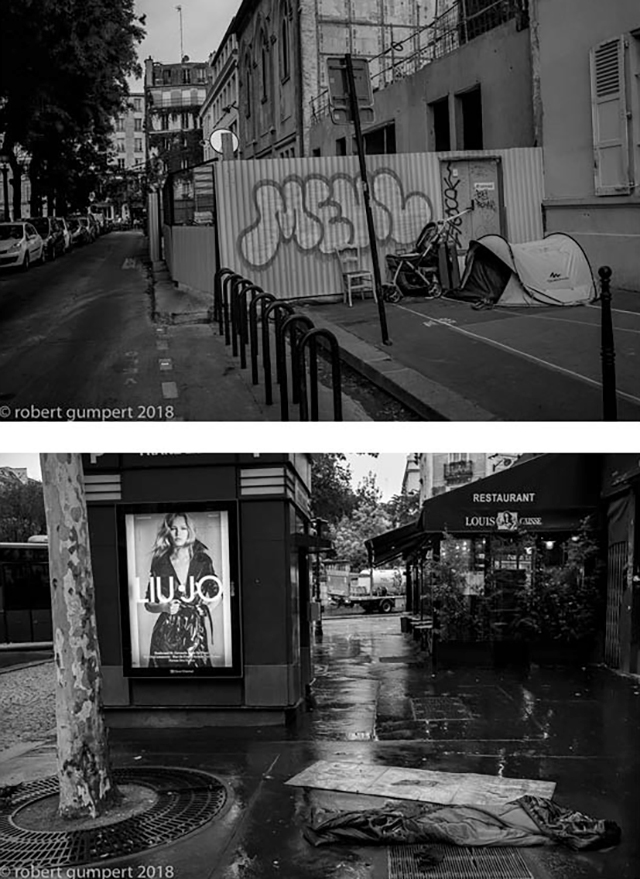
Top: 20 September 2018: Paris. Homeless on the Rue Bossuet near Gare du Nord. Bottom: 20 September 2018: Paris. Homeless near Gare du Nord
Zurich

16 September 2018: Zurich, Switzerland. Mime performer with his “assistant” picked from the audience.
Zurich is amorphous for me but the last night we were there I began to think I know what I would photograph here if I came back. There are a whole lot of “big dick” guys in expensive suits and hair cuts with a posture that says I am a king of the the world. And then, of course, there are the muscle cars – American, German, Italian – lots of roar and quick starts and stops but not much speed as everyone here seems to be studiously obeying the public laws. In banking I would have my doubts.
Paris and Dinan

19 September 2018: Dinan, France. One of the Roger Vène sculptures in the walkway leading to the the Bibliothèque municipale de Dinan.
…
“I knew in my soul that they could not match our passion to protect the working men and women of Missouri.”
By Sonny Costa
The Forum is proud to run once again a dispatch from the fields of working class organizing. This is part two in a series of articles written by Joseph “Sonny” Costa, an organizer with the Heat and Frost Insulators Local 1 in St. Louis, Missouri. On January 23 Sonny described the organizing necessary to get the repeal of Right To Work (RTW) on the ballot in Missouri. Now he profiles the smashing victory achieved on August 7th. Jeff Stansbury covered the first Missouri defeat of RTW for the UAW magazine, “Solidarity” in 1978. Sonny remembers standing with his father at anti RTW rallies 40 years ago as a young boy.
•
“We knocked on doors, over 800,000 of them.”
August 7th 2018, 10:05pm there was no other place I would have rather been than Sports Café surrounded by my family, friends and my brothers and sisters of the Heat and Frost Insulators Local #1 in St. Louis. The culmination of nineteen months of work had paid off in the overwhelming defeat of Proposition A., Missouri’s vote on “Right to Work”. The final numbers were staggering even for those of us who had spent the majority of that time on the front lines of this battle. 937,241 No votes to 452,075 Yes votes. A landslide by any definition. At 10:05pm I finally got the chance to tell everyone that this fight was over, and that we had won. It was a moment I had been thinking about for months. Not one time during those months had I imagined telling that room that we had lost. In my heart I knew long before that moment that we were going to win. I knew that the effort our small local had put into this fight couldn’t be matched by the opposition. I knew in my soul that they could not match our passion to protect the working men and women of Missouri. My brothers and sisters had put their hearts and souls into this fight, and this was our defining moment for the new labor movement. This was the moment we had all worked for, and the feeling of pride in that room was electrifying. I had a friend ask a few days later if it had sunk in yet. I told him that it had sunk in the moment the room broke into a celebration. At that same moment it felt as though a hundred pounds had just been lifted off of my back.
Since March of 2017 the Business Manager of my Local had tasked me with handling our part of this fight. It has taken a lot to get to this point, and I couldn’t be more proud of my brothers and sisters for the time and effort they put into defeating Prop A. I often read peoples comments about how the labor movement is dying. From what I’ve seen the new labor movement is alive, well and just getting started. I can’t speak for other locals in St. Louis but Local #1 shined like I’ve never seen before. The goal that was put out for each local was 1% volunteer and shift participation. Local #1 finished with an unbelievable 2620% participation rate. I was told by the people that ran the campaign that “We were like ants. We were everywhere and showed up for everything”. This is what the labor movement is all about. To be a part of what was accomplished is an absolute honor and something that will always stay with me.
How were we able to pull this off? We did what labor does, we worked. Our leaders laid out a plan, and those of us on the front lines executed that plan flawlessly. Our strategy was one that was aggressive, tireless and unrelenting. We hit the streets and educated the voters of Missouri on what “Right to Work” truly means and what it is meant to do. We knocked on doors, over 800,000 of them. We made over 1,000,000 phone calls. We talked to our family, friends and neighbors. We talked to complete strangers about how every working person in Missouri would lose over 10% of their annual income. We talked to them about how the wealthiest 1% of the country wants to destroy the last of unions. Why? Because we are the only thing stopping them from having complete control of the work force in the United States. Because Unions give the working people the wages and benefits necessary to provide a comfortable life for their families. Unions allow workers the freedom to speak up and be heard when they’re being taken advantage of. It gives people the power to fix things that are broken in the work place. We explained how union wages set the standard of pay. One of my favorite conversations was with a retired gentleman who told me there was no way he was going to vote for Right to Work. He explained to me that he was never in a union. But because of what the union offered, the company he worked for had to be competitive in order to keep the good workers they had.
“The day of the 7th began early. We were working polls starting at 6 AM. The door knocking and phone calls lasted all day.”
Our whole strategy revolved around making sure that our message got out first and repeatedly. We wanted to talk to people face to face to answer any questions or concerns’ they had. What I learned during this process was, its effective. Often when we knocked on a door, after they told us that we had their vote they would ask for yard signs or bumper stickers. But the most gratifying feelings came when people thanked us for being out there fighting to stop the attacks on working people.
The week leading up to the election the campaign shifted into overdrive. This was the Get Out The Vote (GOTV) portion of the campaign and the most aggressive part yet. The GOTV was centered on talking to people who we had already identified as voting with us and reminding them that the vote was one week away. Several people told us that this was the most aggressive campaign they could remember. To that we answered: it’s because of how important it was.
The day of the 7th began early. We were working polls starting at 6 AM. The door knocking and phone calls lasted all day. While working the polls it began to sink in that things looked like they were going in our favor. We were guessing that close to 7 out of 10 people were telling us that the only reason to go to the polls was to vote NO on Prop A. We were hearing about record numbers coming out to vote in a mid-term, primary election. That was good news for us. We figured higher numbers were in our favor.
One of the last moves of Missouri’s GOP dominated legislative session was to move the vote on Prop A from the November mid-term ballot to the Primary ballot in August. This move they said was necessary because businesses were waiting to see how this vote was going to turn out. The reasons for this was actually because they thought the number of voters would be lower and they didn’t think we would show up again in November to vote them out of office. The reports were close to 50% of registered voters came out on August 7th. The highest numbers in a primary in years.
Polls closed at 7:00pm. We made our way to the watch party and began watching the early returns. That’s when we realized that this outcome was never in doubt. The numbers were never closer than 20 points. At 10:05 it was over and we could finally celebrate in earnest.
Earlier I said that what we accomplished in Missouri set in immediately. What did not set in until the following day was how people from all over the country were paying attention. I was flooded by phone calls, e-mails and text messages from all my brothers and sisters from other locals. All of them congratulating us on what we had achieved. We were told from the start that the eyes of the labor movement were upon us, and we did our best to make the labor movement proud.
Moving forward I don’t know where we go or how to capitalize on our success here. More emphasis on organizing? More time and effort spent on educating people on what true unionism means? How can we use this to start winning elections again? People smarter than me will have to come up with these ideas. But for starters I would suggest that legislators stop being afraid to say they support organized labor. Remind people that Union is only a bad word when the 1% hear it. Get our message out to working people that we have a lot to offer. Start organizing more aggressively.
Hopefully the tide is starting to turn in our direction. Hopefully we’ve proved that hard work, determination and cooperation are how these battles are won. This is how my mother, father and organized labor beat “Right to Work” in 1978 in Missouri and this how we beat it again in 2018.
•••
SEA PARTY 2018 aims to ‘Turn the Tide’ in November
By David Helvarg
There are at least ten congressional districts where ocean issues including offshore oil drilling, sea level rise and runoff pollution could have a major impact in November’s elections and where we hope to present ‘Sea Party 2018’ talks this fall to encourage people to ‘Vote the Ocean,’ or as part 49 of my book ’50 Ways to Save the Ocean’ states, ‘Vote for those who Protect the Coast.’ These salty ten include Virginia’s 2nd, North Carolina’s 7th and 9th, South Carolina’s 1st, Georgia’s 1st, Florida’s 16th and 26th and California’s 45th, 48th and 49th.
In 2016 we launched the ‘Sea Party’ at a press conference in Washington D.C. near the U.S. Capitol below a 90-foot inflatable Blue Whale. Speakers included then Rep. Sam Farr (D CA), climate activist Bill McKibben and others from Greenpeace, Surfrider, Blue Frontier and additional ocean conservation groups. We also heard from Rep. Mark Sanford (R SC) who was one of a handful of conservative republicans opposing offshore drilling that at the time was being proposed by the Obama Administration. After our press conference the Post and Courier, the largest newspaper in South Carolina, ran a headline reading: “Mark Sanford – From Tea Party to Sea Party.”
Recently Sanford lost his primary race in South Carolina’s low country 1st district to Katie Arrington who claimed he was not sufficiently pro-Trump. Since becoming the Republican candidate she’s claimed she still supports offshore drilling just not off of South Carolina. That has not convinced at least five Republican and Independent mayors in the district who have endorsed democratic candidate Joe Cunningham because of his stronger anti-drilling position.
On the Georgia coast that, combined with South Carolina’s, contains one third of the eastern seaboard’s salt marshes, republican incumbent Buddy Carter strongly supports offshore drilling. His democratic opponent Lisa Ring states, “No drilling. Period.” With a strong coastal ethic, particularly in the city of Savannah, this is another election where voting blue might literally mean casting a vote for the ocean.
“My family tragically lost someone we love in the Deepwater Horizon disaster, and now the Trump Administration is expanding drilling and obliterating safety protections for workers,” Horton has stated.
The issue of offshore drilling has also surfaced in the House race in Virginia’s 2nd District. Republican Rep. Scott Taylor is opposed to drilling off Virginia but didn’t take a public position until the Trump administration announced plans to open more than 90 percent of federal waters to oil leasing. His challenger, Navy veteran Elaine Luria, opposes drilling and links the area’s growing flooding and king tides to sea level rise – as does the Navy that has its major base in Norfolk. The Virginia tidelands, along with South Carolina and south Florida are among the most vulnerable to rapid sea level rise.
In North Carolina where opposition to drilling is widespread along the coast and Outer Banks Democrat Kyle Horton’s quest to unseat Rep. David Rouzer (R) in the 7th District is personal.
“My family tragically lost someone we love in the Deepwater Horizon disaster, and now the Trump Administration is expanding drilling and obliterating safety protections for workers,” Horton has stated.
Rouzer says he supports drilling “at least 30 miles off the coast.”
The state’s 9th District fight between Democrat Dan McCready and Republican Mark Harris pits a solar energy entrepreneur who sees conservation as a “moral imperative,” against a preacher and strong Trump supporter who beat out a mainstream republican incumbent in the primaries according to a story in The Atlantic.
Florida’s 16th district north of Palm Beach on the east coast includes the Indian River a repeat victim of Harmful Algal blooms (“green gunk”) and rising seas neither of which have been addressed by Republicans at the State or federal level. The 26th district includes the Everglades and Florida Keys where both candidates oppose oil drilling and say they want to address sea level rise. Republican candidate Carlos Curbelo is, like Mark Sanford, an outlier in his party on ocean issues but supportive of Trump on other issues including Taxes and health care. In a toss up district that was also ravaged by Hurricane Irma this raises the question of which party is more likely to drive the House in the right direction on the ocean, environment and climate, in other words which party is more likely to defend the blue in our red, white and blue.
California’s 45th, 48th and 49th are all Southern California Orange and San Diego county districts that while traditionally conservative are going through rapid political and demographic change. Also someone like the 48th district’s incumbent republican Dana Rohrabacher, a right-wing surfer who is both pro-drilling and pro-Russia (even before Trump) raises the question what does conservative even mean anymore?
I’m hoping to give Sea Party talks in these ten districts and maybe also Florida’s 13th that is seeing extensive and ongoing harm from big ag fed wildlife (and tourism) killing red tides in areas such as Sarasota that are also overbuilt and at risk from coastal flooding.
These issues, offshore drilling, climate change but particularly runoff pollution and algae blooms are also expected to play a major role in the Florida Senate race between incumbent Democrat Bill Nelson and Republican Governor Rick Scott who’s long been seen as being in the pocket of Big Sugar whose runoff phosphate and nitrogen feed the blooms.
Having helped organize the global ‘March for the Ocean’ in June I look forward to addressing our need to ‘Vote the Ocean’ this November in order to speak to issues such as offshore drilling and spilling, plastic pollution of our seas and how we can protect our coasts from the worst impacts of climate change and pollution.
At this point the Sea Party 2018 Speaking Tour is doing outreach while still seeking invitations and funding. For more information contact info@bluefront.org or feel free to contact me directly at Helvarg@bluefront.org
•••
The passing of Ron Dellums, leader in the global struggle against apartheid
By Peter Cole
The American congressman, Ronald Vernie (Ron) Dellums, who represented Oakland, California in the U.S. Congress, has passed. As loving tributes pour in, many praise his long-standing commitment to and leader in the global struggle against apartheid. Others highlight his decades-long activism on behalf of civil rights and as a leader of the Congressional Black Caucus. Today, people might look at Dellums, with his coifed Afro, and wonder where black leaders like he are now. But to truly understand Dellums’ radicalism, one must appreciate his family’s commitment to both unions and racial equality.
Crucially, his father, Vernie, was an Oakland longshoreman and proud member of Local 10, the Bay Area branch of the International Longshore & Warehouse Union (ILWU). The ILWU was perhaps the country’s most powerful, left-wing union. The West Coast dockworkers were led by Harry Bridges, an Australian immigrant, hated by conservatives and Cold War liberals because of his commitment to working-class power, unionism, racial equality, and socialism.
His uncle, C.L. Dellums, was the most important black unionist, indeed most influential civil rights leader, in California in the mid 1900s. C.L. led the West Coast locals of the Brotherhood of Sleeping Car Porters. This union was co-founded by A. Philip Randolph, probably the most important black unionist in American history. It was Randolph’s idea to “March on Washington” at which Martin Luther King, Jr. delivered his most famous speech. That 1963 rally, don’t forget, was “for jobs and freedom.”
In a country like the United States, founded upon and still committed to racial capitalism, one always must fight two monsters, racism and capitalism. Indeed, the monstrous Hydra has many heads including sexism, homophobia, xenophobia, and imperialism, as well.
Dellums understood these matters because he was raised by a longshoreman and railroader, each of whom belonged to powerful, anti-racist unions.
When elected to Congress in 1970, Dellums became its most radical member. (It is worth noting that, today, Representative Barbara Lee, who followed Dellums as U.S. representative for Oakland-Berkeley, likely holds that title.) He immediately joined the newly formed Congressional Black Caucus, which advocates for African-American issues in Congress. Shortly thereafter, he co-sponsored a bill (with John Conyers of Detroit) to sanction South Africa for its heinous treatment of its black majority; the racist system known as apartheid—fascist as well as white supremacist—increasingly drew the attention of the world for its odiousness. In his autobiography, “Lying Down with the Lions: A Public Life from the Streets of Oakland to the Halls of Power”,
Dellums understood that organizing demanded foot soldiers as well as policy proposals and he engaged in both.
Dellums wrote that it was radical black workers from the Polaroid Corporation who helped convince him to fight apartheid. They hated that Polaroid cameras were used by the apartheid regime in their notorious passbooks that tightly restricted black freedom of movement.
Also in the 1970s, black and white left radicals in his father’s union, ILWU Local 10, formed the first rank-and-file anti-apartheid committee of any US union. The Southern African Liberation Support Committee organized Local 10 and other ILWU members, starting in 1976, shortly after the Soweto uprising galvanized the struggle, inside South Africa and worldwide. This committee was led by the African American communist Leo Robinson with key support from an anti-imperialist New Left white, Larry Wright.
In October 1984, the Southern African Liberation Support Committee, along with support from a Trotskyist caucus, gained the unanimous support of Local 10 members to boycott apartheid cargo. The following month, just weeks after President Ronald Reagan’s landslide re-election, longshoremen refused to touch the South African cargo that had arrived aboard a Dutch ship. For the next eleven days, thousands of Bay Area residents, including Angela Davis, rallied in solidarity with the dockworkers at San Francisco Pier 80.
The same week, in Washington, DC, Dellums became one of the first protesters arrested for sitting-in at the South African embassy. His arrest was part of the strategy of the newly-created Free South Africa Movement.
Dellums understood that organizing demanded foot soldiers as well as policy proposals and he engaged in both. He marched (and got arrested) for challenging apartheid in South Africa and South African-controlled Southwest Africa (now Namibia). He also built a coalition in Congress that passed a bill that sanctioned South Africa and divesting from it, meaning that the United States would not engage in trade until apartheid ended.
Of course, Reagan vetoed the bill. However, in a stunning rebuke, a bipartisan group overrode Reagan’s veto. US sanctions, along with similar efforts in countries worldwide, gave support for the United Democratic Front, the social movement inside South Africa. In 1990, Nelson Mandela was freed from prison after 27 years, as were other political prisoners, and many organizations, including the African National Congress, were un-banned.
In 1990, Dellums flew to Lusaka, Zambia to meet Mandela and other ANC leaders. That was when he achieved the dream of many in the African diaspora, including his mother. He also visited South Africa.
That same year, Mandela first visited the United States, a ten-day tour to cities that had participated in the black freedom struggle. His last stop was Oakland, where he spoke to 60,000 adoring people. Dellums hosted the rally.
When Mandela finally came on, ten percent of his speech was devoted to thanking the longshoremen for their efforts. Dellums, the son of a Local 10 member, must had nodded knowingly.
Dellums was a black radical all right. But he also was a socialist though he had mellowed over the years. Yet he always understood—and centered—the struggle of working people, especially the African American, Asian, and Latino members of his district in Oakland and Berkeley.
Ron Dellums, the son of an Oakland longshoreman, fought the good fight. He appreciated the struggle against racism is permanently joined with those against sexism, militarism, and capitalism. He was intersectional before intersectionality was a thing. Presente!
•••
This post first appeared on Africa is a Country
All Out for the Mid-terms: Democrats Must Retake the House to Put the Brakes on Trump!
By Peter Olney and Rand Wilson
“L’estate sta finendo” (The summer is ending)
“E un anno se ne va” (And a year is going by)
“Sto diventando grande” (I am growing up)
“Lo sai che non mi va.” (You know I don’t like that)
The popular Italian hit captures all we need to say about the coming period. Before long the summer will be over and for many of us it’s time to get down to business on our most important political task: To flip the U.S. House of Representatives into the hands of the Democrats.
Not everyone on the left agrees. For example, Chris Hedges recently wrote, “The Democratic Party elites…are creations of the corporate state. The Democratic Party is as much to blame for Trump as the Republicans. It is a full partner in the perpetuation of our political system of legalized bribery, along with the deindustrialization of the country, austerity programs, social inequality, mass incarceration and the assault on basic civil liberties. It deregulates Wall Street. It prosecutes the endless and futile wars that are draining the federal budget. We must mount independent political movements and form our own parties to sweep the Democratic and Republican elites aside or be complicit in cementing into place a corporate tyranny.”(1)
We don’t disagree with much that Hedges says about the Democratic Party — except his last sentence. With the right wing rising, quixotic talk of “forming our own parties” or being “complicit with corporate tyranny” by supporting Democrats is pure fantasy. It completely misses the necessity of a building a united front against a dangerous far right nationalist movement led by Trump and his backers.
As the song says, we are getting older and hopefully a little more mature and we can understand the critical importance of putting the reins on the erratic, racist, misogynist, anti-labor monster who sits in the White House. For one of the best discussions of Democratic Party “lesser of two evils” dilemmas, we strongly suggest reading longtime DSA activist and former legislator Tom Gallagher’s “The Primary Route.”
Now is the time to hold our noses and elect Democrats – many of whom may not fit the progressive mold – in “swing districts.” That’s why we support “Swing Left,” an initiative coordinating this effort that helps people find — and commit to supporting — progressives in their closest Swing District to ensure that we take back the House in 2018.(2)
This is not to understate the importance of building a strong bench of progressive candidates at the municipal, county and state level. However, the importance of those contests, often in places where differences are minimal, pales in comparison to the job of putting the political brakes on Donald Trump. The country and the earth’s future will feel the impact if we fail in November.
So, we urge people to get ready to head to the “red” and “purple” districts where vulnerable House Republicans can be beat. These races are crying out for volunteers, donations and brio!
There are plenty of places to go for September and October to help organize on the ground. Make your travel plans now, because some of these districts may be crowded with folks who are setting out to do this important work.
If you can’t travel, there are many other ways to take action. You can donate or host a fundraiser for District Funds to give Swing District Democrats a boost the day they become the official nominee. You can host or attend a Voter Contact Event. Or start using new phone banking technology to talk to voters in a Swing District.(3)
The authors have already made their own plans:
Peter Olney plans to spend September and October in Southern California working on the 39th Congressional campaign of Democrat Gil Cisneros. He is running to flip this Eastern LA County/Orange County seat, which Hilary carried by 8.5% points in the 2016 election. The incumbent Republican Ed Royce has resigned, but his former aid, Young Kim is running to replace him. Peter has a strong personal interest in this project – his return to Italy is contingent on winning a Democratic majority.(4)
Rand Wilson is deciding between devoting his time to the contest for an open seat in New Hampshire’s First Congressional District that could easily go Republican or campaigning for Jared Golden, the Democrats’ nominee challenging Republican Rep. Bruce Poliquin in Maine’s 2nd Congressional District race.(5)
Regardless of the outcome of the U.S. elections in November, there is so much important grassroots organizing to do in the U.S. — and Italy. Avanti Popolo!
Notes:
1: Et Tu, Bernie? “Et “, Chris Hedges
2: Learn more at swingleft.org. According to Swing Left, there are 78 Swing Districts. These are places where the last election was won by 15% of the vote or less, where Hillary Clinton beat Donald Trump, where a high concentration of volunteers could make certain districts winnable, or where other, specific circumstances make it a competitive district. Democrats need to flip at least 23 seats to take back the House in 2018. If they hold on to the vulnerable Democratic-held districts, they only need to flip 23 Republican-held House seats to take back the house in 2018.
3: Interested in learning more or questions about how to get involved? Contact Swing Left at host@swingleft.org.
4: Peter promised his Italian friends that he won’t return to Italy unless we flip the House, although a return to Italy is beset with such a similar government, the product of some of the same right-wing populist forces that elected Trump.
5: The 2nd district backed Barack Obama in the 2012 presidential election by a margin of 9 points, before flipping red in 2016 for Donald Trump (R), who won by 10 points.
